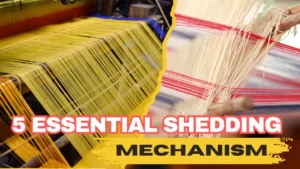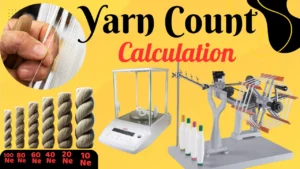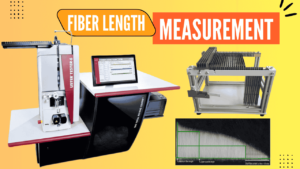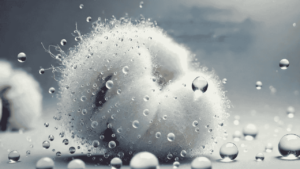What is Polyester fiber?
Polyester is a synthetic fiber that’s typically attained from petroleum. This fiber is one of the world’s most popular filament fibers and it is used in thousands of different consumer and manufactured products. Ethylene polyester is the most produced form of polyester fiber. Depiction of polyester according to F.T.C-
Polyester filament are chemically formulated of at least 85% by wt. of an ester of a substituted aromatic carboxylic acid, including but not confined to substituted Terephthalate units and Para substituted hydroxyl benzoate units.
Polyethylene Terephthalate, the repeating unit of the polyester polymer with a degree of polymerization of 115-140 units (i.e. n= 115-140).

Polyester fiber manufacturing process:
Step-1: Creating a Monomer
The procedure of creating polyester filament begins with the reaction of ethylene glycol with dimethyl terephthalate at extensive heat. This composition results in a monomer.
Step-2: Creating a polymer
Further addition of dimethyl terephthalate with the resulting monomer to create a polymer.
Step -3: Extruding
This molten polyester polymer is extruded from the reaction chamber in long stripes and these stripes are allowed to cool and dry and then they are broken apart into small pieces.
Step-4: Spinning
Polyester basically go through melt spinning system. The resulting chips are then melted again to create a honey like substance which is extruded through spinneret to create fibers. The fibers are then transferred to winding machine and produce a sliver that looks like noodles. Then the slivers are taken to the creel stage. This creel is the first stage of drawing section. Into the roller of drawing machine, the slivers are drafted in several steps by using chemicals like lubricant and titanium dioxide. Then we get 1.4 denier primary fiber. This primary fiber automatically runs into the dryer to get moisture free smooth fiber. Moisture free primary fiber automatically transfers to the cutting machine and cut it into desired length as per the requirement of the buyer. After cutting we get the moisture free smooth polyester staple fibers.
Flow Chart Of Melt Spinning System

Reaction In The Polymerization Of PET Polyester:

Characteristics Of Polyester Fiber:
1. Fibers are extremely strong.
2. Very durable.
3. Resistant to most chemicals.
4. Stretching and shrinking.
5. Wrinkle resistant.
6. Mildew and abrasion resistant.
7. Hydrophobic in nature.
8. Quick drying.
9. Easily washed and dried.
10. Retains its shape
11. Good for making outdoor clothing for harsh climates.
End Usage Of Polyester Fiber:
Polyester fiber is used alone or blended with wool, cotton, flax and other fibers provides-
1. An extensive range of hard-wearing.
2. Comfortable.
3. Easily looked after garments.
4. High dimensional stability.
5. Wrinkle resistance.
Use of polyester in apparel-
1. Reduces production costs but it also decreases the comfort ability of apparel.
Use of polyester also covers-
1. Curtains.
2. Floor coverage.
3. Laundry equipment.
4. Conveyor belt.
5. Ropes.
6. Net.
7. Sail cloth.
8. Sewing thread.
9. Electrical insulation.
While some forms of polyester are biodegradable, most of them are not biodegradable and polyester production and use contribute to pollution around the world.




40 thoughts on “Polyester Fiber Manufacturing Process”
Awesome sir
Very much informative
Very much informative, tnx sir!!
Helpful information thank you sir
Thank you sir. It’s very important information
Very informative article…
Hi sir
Informative article
This creel is the first stage of drawing section. Into the roller of drawing machine, the slivers are drafted in several steps by using chemicals like lubricant and titanium dioxide. Then we get 1.4 denier primary fiber. This primary fiber automatically runs into the dryer to get moisture free smooth fiber.
Assalamualaikum Sir.
Very helpful & informative article…
Its is vry helpful🖤
Excellent topic
Thank you sir. It’s very important information.
The topic is great
Big Fan Sir ❤️
Informative article
Important topic
This information is very helpfull for us.
Such a helpful article this is. Thank you so much sir!!!!
The figure of melt spinning system is very easy to understand and beneficial
Thank you sir for this initiative. This information will be very helpful for us.
Thanks for sharing such informative article on Polyester. It has some very interesting characteristics.
Well organized and very informative.Thank you sir.
The most interesting part was for me the processing of polyester fibre. The visual conception make it more easy, dimethyl terephthalate was using in two steps here, creating monomer also for polymer…though it is hydrophobic it dries out so easily and wrinkled resistant, so practical. Thank you sir for this informative article. (AE-26, 13th batch)
It’s so much helpful & educative topic for everyone, who works in Textile industry.
Such a helpful article this is. Thank you so much sir💞
Best article on polyester fiber ever!
Very helpful & informative article…
So important topics,sir.It will help me.
Very Important Topics sir.
Well organized and very informative.Thank you sir.
Very nicel
Topic very good sir…..
The diagram of spinning system is very easy to understand and useful, as I am employed in spinning.
Very informative sir.Thank you so much
Good explanation. Thanks sir.
Helpful information thank you sir
Hello guys! Good article Textile Explainer : Smart Platform for Textile Learners
Что есть на Mega? Пять тысяч продавцов с разными позициями. Вы определенно найдете нужный. Обменник – возможность купить Биткоин на Мега, обменяв qiwi. Анонимные записки между клиентами Privnote. Нет надобности использовать Telegram. Решение конфликтных ситуаций с модератором через «диспут». И это далеко не все. На сайте даже есть отдельная страница со всеми функциями и особенностями данного ресурса мега даркнет ссылка .
mega darknet зеркала
mega sb
mega
[url=https://xn--meg-sb-yoc.com]мега онион [/url]
Your blog is so much more than just a collection of posts It’s a community of like-minded individuals spreading optimism and kindness